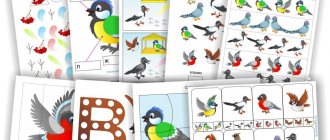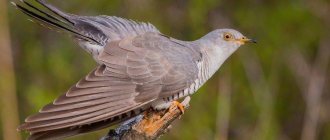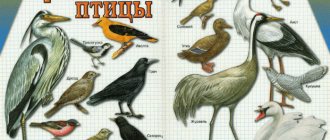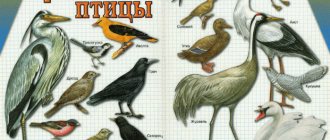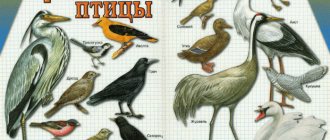Lifestyle
When studying the bird fauna of any area, one can note the variability of its composition at different times of the year. In fact, very few birds live with us both winter and summer. This is largely due to seasonal changes in the lives of birds. In this regard, according to their lifestyle, all birds can be divided into three groups: sedentary, nomadic and migratory.
After winter comes a revival in nature. With the arrival of spring, significant changes occur in the lives of birds. Migratory birds return from wintering grounds.
For life, birds choose areas with favorable conditions, organizing nesting in the same place year after year. Here the male begins to sing, luring the female, and notifying others that the place is occupied. Birds, when choosing their life partners, attach great importance to the color of their plumage. Therefore, males have brighter colors to attract females.
Many people choose a pair for one season. However, birds are known in which pairs form for a long period or for life. For example, storks, herons, swans and birds of prey.
After the pair is formed, a crucial period begins. In the life of birds, spring is the time for breeding, and then caring for the offspring. To do this, they begin nest-building, laying eggs and raising chicks.
Caring for offspring: a penguin protects a chick from a petrel
In wildlife you can observe very interesting moments from the life of birds. For example, bird markets are of great interest. A striking example of such social life is the mass nesting of birds in the north. Birds live in a colony and work together to protect their young from predators. Such collective life makes it possible to preserve offspring, protect themselves from predators, and thereby increase the life expectancy of birds.
Bird market in Kamchatka
After spring and summer come the first cold days. The life of animals and birds in the fall is aimed at preparing for the winter cold. Birds that cannot find food in the cold fly away to warm countries. It is generally believed that birds fly south. Bird ringing has shown that many of them fly to the west and southwest. The autumn flight of birds is extended over time. It lasts about three months.
The first snowfall in autumn causes anxiety among birds. The first changes in the way of life of birds are taking place. Sedentary birds switch to coarse, low-nutrient woody food - buds, shoots and needles. Many birds migrate for the winter closer to populated areas. Nomadic birds begin to appear.
Nomadic birds - waxwings
It is difficult for all living things in this harsh season of the year. The cold hinders the movements of birds. Lack of food and death of forest inhabitants are often observed. It is within our power to take care of our feathered friends and organize feeding. It’s not difficult to make a simple feeder and hang it out the window in the yard, garden or park. We will save many birds from hunger and help them survive until the first warm days of spring.
Sparrows and tits at the feeder
Birds will not remain in debt, because they bring great benefits to humans. The positive significance of birds in human life lies in the destruction of insects and rodents - agricultural pests. Such useful birds include all insectivores, such as tits, nuthatches and others. It is impossible not to say about woodpeckers, which eat harmful insects: bark beetles, click beetles, golden beetles, etc.
White-backed Woodpecker
Owls and owls are considered energetic hunters of mouse-like rodents. Birds of prey also destroy mice: buzzard, kestrel, harrier, etc.
Gray owl with prey
Birds are of great economic and commercial importance. Some birds provide tasty meat (hazel grouse, black grouse, wood grouse, ducks, etc.), while other birds provide valuable feathers (eiders, loons, geese).
Representatives of the chicken and anseriformes orders are domesticated. Poultry farming is a large livestock industry that supplies food.
Poultry meat is very nutritious and tasty. Chicken eggs are a valuable food product.
Chickens at a poultry farm
The importance of birds in nature is also very significant. Birds, as already mentioned, regulate the number of living organisms. Sometimes birds themselves serve as food for other animals, being a link in the food chain.
Without these animals, the seeds of many plants would not be distributed over significant distances. Pecking at various berries, they throw out intact seeds with droppings, often far from the place where they grew.
Bird reproduction and development
Birds are dioecious. The reproductive organs of a male are 2 testes; in female birds, there is 1 left ovary and an oviduct.
The reproduction and development of birds, as well as that of reptiles, occurs on land.
What features can be noted in the reproduction of birds?
The breeding season of birds begins in the spring with the formation of pairs. Males attract the attention of the opposite sex with spring singing. After a pair is created, the process of bird reproduction or mating occurs.
Mating season of pigeons
The reproduction of birds and reptiles is similar in many ways. Fertilization in these classes of animals is internal, and reproduction occurs with the help of eggs.
A feature of bird reproduction is the formation of eggs covered with a hard shell. After fertilization, the development of the bird embryo begins, a shell of protein is formed around the yolk. In turn, the protein is covered with a subshell shell and a hard calcareous shell. As a result, an egg is formed. Let's get acquainted with the structure of a bird's egg in the figure.
The rapid growth and development of the bird embryo occurs only after the egg is laid and the animals begin incubation.
During the breeding season, many birds begin to build a nest for future chicks. Bird nesting structures can be primitive or can be complex structures. The shape and material used for construction are varied.
The female lays eggs in a nest, which are incubated by both parents in turn. In some species, such as chicken and duck, one female incubates the eggs. The incubation period for eggs can last from 13 days in small birds to 2 months in birds of prey.
According to the type of development, birds are divided into brood and nesting birds.
Breeding birds include cranes, waders, gulls, and swans. According to the type of development, domestic birds - geese, chickens, ducks - also belong to brood birds. Breeding birds include passerines, birds of prey, woodpeckers, and pigeons.
Photo gallery: examples of children's work on the topic “Birds”
The image of the Firebird is conveyed very elegantly - with a combination of yellow and orange colors
The poking method allows you to convey the fluffiness of a swan
The background is very beautifully designed - the sky
The multi-colored image of the cockerel echoes the variegated flowers with petals of the same tones
Bright colors combined with unconventional techniques give an original result
The plot composition has many characters
Pencil produces soft pastel colors
Subject compositions are often easier to depict with pencils
The black and yellow titmouse looks beautiful against the background of blue snow
The fairytale bird looks more like a small chick hiding in a pine branch
You can unusually convey the loose tail of almost any bird with your palm
Future schoolchildren learn to draw sitting birds
The image of an owl encourages the use of unconventional techniques
Using foam rubber, the shaggy plumage of an owl is well conveyed
The owl's plumage is originally rendered in the form of brown zigzags on a yellow background.
The images of sparrows pecking grains are conveyed very realistically
Beautiful subject composition, gives the impression of birds moving
Children usually love to portray living creatures, especially those that they can observe in nature. That's why the theme "Birds" is always popular with preschoolers. Many pupils of the preparatory group are able to accurately notice the characteristic features of different birds and convey them through drawing, harmoniously building a composition. The main thing for the teacher is to captivate the students, motivate them to be creative, and provide some interesting information that will additionally awaken interest in birds.
Origin of birds
Many modern paleontologists believe that the origin of birds is related to reptiles. The origin of birds from reptiles is indicated by some similarities.
Imprints of an unknown animal were found in the layers of the earth's crust. Scientists have restored its appearance; it had signs of a reptile and a bird. This animal was called “Archaeopteryx” and was classified as a primordial bird or lizard-tailed bird. The skull with teeth resembled reptiles, but the whole body was covered with feathers. The forelimbs looked like wings, only the fingers had claws. This proves the origin of the bird's wing from the forelimb of reptiles.
Ancient birds lived in trees, jumped and climbed branches. They could stay in the air and fly short distances. The origin of birds proves that the evolution of this class followed the path of adaptation to flight.
Specific options within the theme “Birds”
According to T. Komarova’s fine arts program, in the preparatory group two lessons are devoted to drawing birds: this is drawing an illustration for the work of Mamin-Sibiryak “The Gray Neck” and “The Magic Bird”. However, the topic of birds is so interesting and multifaceted that the teacher clearly should not limit himself to only this. So, options for the feathered theme could be as follows:
- Owl-owl (a very bright image that can be depicted in different techniques).
- A flock of migratory birds (theme is proposed in autumn or spring).
- Cockerel is a golden comb (can be associated with some fairy tale, for example, “The Cockerel and the Bean Seed” or “The Tale of the Golden Cockerel” by A. S. Pushkin).
- Titmouse (you can draw on November 12 or not far from this date, when people celebrate Titmouse Day).
- Bullfinches on a branch (of course, this theme is offered in winter).
- Swallow (it’s good to connect the image with the fairy tale “Thumbelina”).
- Poultry (poultry yard as an option). A child can simultaneously portray a chicken, a rooster, a duck, a goose, a turkey, or one or the other.
- White-sided magpie.
- Swan on the lake (as a variant of the swan princess of A.S. Pushkin before her transformation into a girl or an illustration for Andersen’s fairy tale “Wild Swans”).
- Kargopol birds (drawing based on folk toys).
- Fairytale bird (Firebird).
Older preschoolers always find collective compositions interesting. The “Magic Bird” work is popular, when each child paints a feather to his own taste, and then a gorgeous tail is assembled from them (the teacher prepares the base in advance - the body of the bird).
Each child paints the feather according to their wishes, and together they make up the original tail of a fairy-tale bird.
Here again, you can take an individual approach and invite some children to color two feathers.
Another option for joint creativity is “Birds at the feeder.” The teacher draws a tree with branches and a feeder, and preschoolers complete the composition with birds.
The theme “Birds” encourages the creation of collective compositions
Bird class classification
This class is represented by a wide variety of species, which are divided into 40 orders. Let's look at the most famous of them.
- The penguin order belongs to the swimming birds. These are peculiar Antarctic birds that have a sac-like body and flipper-like wings covered with scales.
The habitat of these birds is water - penguins swim and dive well. On the ground they move awkwardly.
Penguins in the water
They lead a social life - they create colonies on the sea coast. They form pairs that last a lifetime. Nests are made on the shore in depressions. Both parents incubate the eggs
Representatives of the penguin order of birds are considered to be the emperor penguin, the adélie penguin, and the lesser penguin.
Emperor penguins with chicks
- One representative belongs to the order Ostrichidae - the African ostrich. Found in semi-deserts of Africa. Outwardly, it is a large flightless bird with long, strong legs.
African ostriches
Ostriformes are nomadic birds. They stay in groups - the male leads 3 to 5 females. They lay eggs in the sand, making a hole. The male and female take turns incubating. Ostriches belong to brood birds - the chicks are sighted and covered with down. The male is responsible for raising the chicks.
Ostrich on the nest
- The rhea order includes two species - the common rhea and the long-billed rhea. They live in South America. They are flightless and good running birds. They form small herds, which are led by the male. The male arranges the nest by making a hole and lining it with grass. The male sits on the nest and teaches the chicks. Like ostriches, rheas are breeding birds.
American ostriches or rheas
- The cassowary order is represented by 2 families – cassowaries and emus. Cassowaries, like ostriches, are flightless. They live in Australia and the Pacific Islands. Cassowary birds have a horny outgrowth on their heads. The most famous representative of cassowaries is the helmeted cassowary. They live in pairs, with the male building the nest, incubating the eggs and raising them.
Cassowary with chicks
Representatives of the cassowary order include emus - Australian ostriches. In appearance they are very similar to rhea. Unlike cassowaries, they do not form pairs and graze in herds. The male builds a nest in which the female lays eggs. The male incubates the eggs.
Emu with chicks
- The wingless order includes very interesting small New Zealand birds - kiwi. The wings of these birds are not developed, but they have short, strong legs. The feather cover is very similar to wool. Pairs are formed during the breeding season. The male and female take turns incubating the eggs.
Kiwi
All types of kiwi are listed in the Red Book, as their numbers are constantly declining. The destruction of the forests that are their habitat had a great impact.
The kiwi is the national bird of New Zealand and is used as an emblem.
New Zealand kiwi coin
- The order Gallini belongs to land or arboreal birds. Representatives are characterized by a short and bent beak and short rounded wings. The toes of the hind limbs have claws adapted for digging soil and debris.
Individuals exhibit pronounced sexual dimorphism - males are brighter colored than females. Pairs are formed during the breeding season. The female is busy caring for the offspring. They belong to the breeding birds. Many representatives of this order are domesticated - chickens, guinea fowl, turkeys.
- The order Passeriformes is represented by a large number of modern birds. The appearance and size of the representatives of this order are varied. Common to all passerine birds is development according to the nesting type. The chicks hatch weak and naked. Parents take care of their offspring until a certain period of time.
Many representatives are long-distance migrants, wintering in tropical or other warm countries. The most famous families are swallowtails, larks, shrikes, starlings, corvids, tits, nuthatches, finches, buntings, etc.
- The order Craniformes includes birds united by common characteristics. The most typical representatives of the order of birds are cranes. They are distinguished by a thin long neck, long legs, and a strong, straight, sharp beak. They live mainly in swamps or lakes. They create pairs during the mating season. They belong to the breeding birds.
Mating dance of cranes
The arrival of these birds from warm regions will mark the arrival of spring. The birds fly, lining up in a triangle with a loud purr.
Wedge of cranes
- The bustard order is represented by large and massive birds. They live in steppe regions. They are characterized by a thick neck, flattened beak, and three-fingered limbs. They can run well, but can also fly.
They do not form steam. The female is responsible for arranging the nest and incubating the eggs.
The bustard is listed in the Red Books, as it has long been the object of hunting, which led to a reduction in numbers.
- The order Ankleidae unites birds that live mainly in warm countries. The most striking features of birds of the order volatidae are the long neck, beak and legs. Includes six families. Representatives of two families live in Russia - storks and herons.
The heron family includes herons, bitterns, and night herons.
great egret
Of the stork family, the most famous are the white and black storks. The black stork is listed in the Red Book of Russia.
Black storks in a nest with chicks
- The order of diurnal predators has a hooked beak and strong curved claws on its paws. These structural features are needed for catching prey. Birds are active during daylight hours, which is why they are called diurnal predators. During the breeding season they form pairs. Both adult birds participate in raising the chicks.
Osprey
In Russia there are ospreys, honey beetles, kites, harriers, buzzards and others.
Many representatives are listed in the Red Books of various levels.
- The owl order has some similar characteristics to diurnal predators. These birds are characterized by a strong curved beak, feathered paws with curved sharp claws. They are active at night, so their vision and sensitive hearing are well developed. The plumage is soft and loose, which allows it to fly silently. They live in forests, parks, and can be found near human habitation.
The largest owl is the eagle owl
They form pairs for life. Nests are built in secluded places, and the female incubates the eggs.
Gray owl with chicks
- The order Woodpeckers includes birds with a strong beak adapted for chiseling bark and wood. Thus, they obtain food for themselves and create hollows. Capable of climbing tree trunks. All are active during the day and sleep in hollows at night.
The most famous species are the hoary, yellow, great spotted woodpecker, middle spotted woodpecker and lesser spotted woodpecker.
gray woodpecker
- The order Anseriformes belongs to waterfowl. As a result, they developed webs between their toes. The plumage and lubrication with secretions of the coccygeal gland protects it from getting wet. There is a wide and flat beak. They form pairs and are considered breeding birds. Representatives are geese, swans, and ducks.
Bean goose
